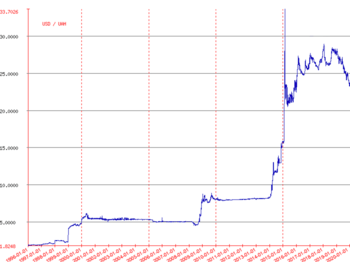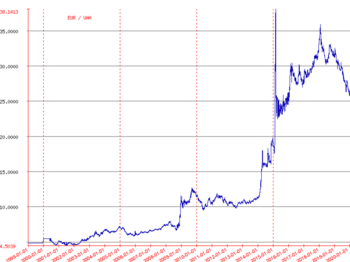Ukrainian hryvnia
The hryvnia, hryvna, or sometimes hryvnya (/(hə)ˈrɪvniə/ (hə-)RIV-nee-ə; Ukrainian: гривня [ˈɦrɪu̯nʲɐ] (![]()
| Ukrainian hryvnia | |||||
|---|---|---|---|---|---|
| українська гривня (Ukrainian) | |||||
| |||||
| ISO 4217 | |||||
| Code | UAH | ||||
| Number | 980 | ||||
| Exponent | 2 | ||||
| Denominations | |||||
| Subunit | |||||
| 1/100 | kopiyka (копійка) | ||||
| Plural | hryvni (nom. pl.), hryven (gen. pl.) | ||||
| kopiyka (копійка) | kopiyky (nom. pl.), kopiyok (gen. pl.) | ||||
| Symbol | ₴ or грн | ||||
| Banknotes | |||||
| Freq. used | ₴1, ₴2, ₴5, ₴10, ₴20, ₴50, ₴100, ₴200, ₴500 | ||||
| Rarely used | ₴1,000 | ||||
| Coins | |||||
| Freq. used | 10, 25, 50 kopiyok; ₴1, ₴2 | ||||
| Rarely used | Commemorative and jubilee coins, ₴5, ₴10 | ||||
| Demographics | |||||
| User(s) | |||||
| Issuance | |||||
| Central bank | National Bank of Ukraine | ||||
| Website | www.bank.gov.ua/en | ||||
| Printer | National Bank of Ukraine | ||||
| Mint | National Bank of Ukraine | ||||
| Valuation | |||||
| Inflation | 8.6% (03.2019 y-o-y)[1] | ||||
| Source | NBU, 2019, May [2] | ||||
| Method | CPI | ||||
Name
Etymology
The currency of Kievan Rus’ in the eleventh century was called grivna. The word is thought to derive from the Slavic griva; c.f. Ukrainian, Russian, Bulgarian, and Serbo-Croatian грива / griva, meaning "mane". It might have indicated something valuable worn around the neck, usually made of silver or gold; c.f. Bulgarian and Serbian grivna (гривна, "bracelet"). Later, the word was used to describe silver or gold ingots of a certain weight; c.f. Ukrainian hryvenyk (гривеник), Russian grivennik (гривенник, "10-kopek piece").
The modern Ukrainian hryvnia is sometimes transliterated as hryvna, hrivna, gryvna or grivna, due to its Russian language counterpart, гри́вна, pronounced grívna. However, the standard English name for the currency is hryvnia.[3]
The National Bank of Ukraine has recommended that a distinction be made between hryvnia and grívna in both historical and practical means.
Plural
The nominative plural of hryvnia is hryvni (Ukrainian: гривні), while the genitive plural is hryven’ (Ukrainian: гривень). In Ukrainian, the nominative plural form is used for numbers ending with 2, 3, or 4, as in dvi hryvni (дві гривні, "2 hryvni"), and the genitive plural is used for numbers ending with 5 to 9 and 0, for example sto hryven’ (сто гривень, "100 hryven’"); for numbers ending with 1 the nominative singular form is used, for example dvadciat’ odna hryvnia (двадцять одна гривня, "21 hryvnia"). An exception for this rule is numbers ending in 11, 12, 13 and 14 for which the genitive plural is also used, for example, dvanadciat’ hryven’ (дванадцять гривень, "12 hryven’"). The singular for the subdivision is копійка (kopiyka), the nominative plural is копійки (kopiyky) and the genitive is копійок (kopiyok).
Currency sign

The hryvnia sign is a cursive Ukrainian letter He (г), with a double horizontal stroke (₴), symbolizing stability, similar to that used in other currency symbols such as the yen (¥), euro (€) or Indian rupee (₹). The sign was encoded as U+20B4 in Unicode 4.1 and released in 2005.[4] It is now supported by most systems. In Ukraine, if the hryvnia sign is unavailable, the Cyrillic abbreviation "грн" is used.
History
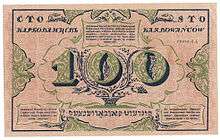
A currency called hryvna was used in Kievan Rus'. In 1917, after the Ukrainian National Republic declared independence from the Russian Empire, the name of the new Ukrainian currency became hryvnia, a revised version of the Kievan Rus' hryvna. The designer was Heorhiy Narbut.
The hryvnia replaced the karbovanets during the period 2–16 September 1996, at a rate of 1 hryvnia to 100,000 karbovantsiv.[5] The karbovanets was subject to hyperinflation in the early 1990s following the collapse of the USSR.
To a large extent, the introduction of the hryvnia was secretive.[6] The hryvnia was introduced according to a Presidential Decree dated 26 August 1996 that was published on August 29. During the transition period, 2–16 September, both hryvnias and karbovanets were used, but merchants were required to give change only in hryvnias. All bank accounts were converted to hryvnias automatically. During the transition period, 97% of karbovanets were taken out of circulation, including 56% in the first five days of the currency reform.[6] After 16 September 1996, the remaining karbovanets could be exchanged for hryvnias in banks.
The hryvnia was introduced during the period when Viktor Yushchenko was the chairman of National Bank of Ukraine. However, the first banknotes issued bore the signature of the previous National Bank chairman, Vadym Hetman, who resigned in 1993, because the first notes had been printed as early as 1992 by the Canadian Bank Note Company, but it was decided to delay their circulation until the hyperinflation in Ukraine was brought under control.
On 18 March 2014, following its annexation by Russia, the new Republic of Crimea announced that the hryvina was to be dropped as the region's currency in April 2014.[7] The Russian ruble became the "official" currency in annexed Crimea on 21 March 2014.[8] Until 1 June 2014, the hryvnia could also be used for cash payments only.[8]
By contrast, the hryvnia remains the predominant currency in the conflicted raions of Donbass, i. e. in the secessionist areas of Donetsk and Luhansk.[9]
Coins
No coins were issued for the first hryvnia.
Coins were first struck in 1992 for the new currency but were not introduced until September 1996. Initially coins valued between 1 and 50 kopecks were issued. In March 1997, 1 hryvnia coins were added. Since 2004 several commemorative 1 hryvnia coins have been struck.
In October 2012 the National Bank of Ukraine announced that it is examining the possibility of withdrawing the 1- and 2-kopeck coins from circulation.[10] The coins had become too expensive to produce compared to their nominal value. Due to actual reports 1- and 2-kopek coins are not produced anymore since 2013, but will remain in circulation until 1 October 2019.[11]
Also, on 26 October 2012, the National Bank of Ukraine announced it is considering the introduction of a 2-hryvnia coin.[12]
As of 1 July 2016, officially 12.4 billion coins with a face value of 1.4 billion UAH were in circulation.[13]
On 1 October 2019, 1, 2 and 5 kopek coins ceased to be legal tender. They can be still changed at banks, but bills have to be rounded to the next 0.10-step.[14]
| Coins of the Ukrainian Hryvnia (1992–present)[15] | ||||||||||||
|---|---|---|---|---|---|---|---|---|---|---|---|---|
| Image | Value | Technical parameters | Description | Date of | ||||||||
| Obverse | Reverse | Diameter | Mass | Composition | Edge | Obverse | Reverse | minting | issue | withdrawal | ||
 |
 |
1 kopiyka | 16. mm | 1.5 g | Stainless steel | Plain | Value, Ornaments |
Ukrainian Trident | 1992~present | 2 September 1996 | One-, two-, and five-kopiika coins ceased to be legal tender in Ukraine and gone out of circulation, effective 1 October 2019[16] | |
 |
 |
2 kopiyky | 17.30 mm | 0.64 g (1992~1996) 1.8 g (2001-) |
aluminium (1992–1996), stainless steel (2001-) | |||||||
 |
 |
5 kopiyok | 24 mm | 4.3 g | stainless steel | Reeded | ||||||
 |
 |
10 kopiyok | 16.3 mm | 1.7 g | brass (1992–1996), aluminium bronze (2001-) |
Current | ||||||
 |
 |
25 kopiyok | 20.8 mm | 2.9 g | Reeded and plain sectors | Current but not issued since 1 July 2018.[17] In addition, the 25-kopiika coin will continue to be used as legal tender for now, but will be phased out eventually.[18] | ||||||
 |
 |
50 kopiyok | 23 mm | 4.2 g | Current | |||||||
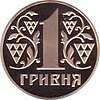 |
 |
1 hryvnia | 26 mm | 7.1 g (1995,1996) 6.9 g (2001-) |
brass (1995, 1996), aluminium bronze (2001-) |
Inscription: "ОДНА ГРИВНЯ", minted year | 1995~2013 | 12 March 1997 | Current, but new design introduced in 2018 | |||
| 1 hryvnia | 26 mm | 6.8 g (2004-2016) | Aluminum bronze (2004-2016) | Plain with incuse lettering ("ОДНА · ГРИВНЯ · Date of issue") | Inscription: Coat of arms of Ukraine; УКРАЇНА 1 ГРИВНЯ; date of issue inside a decorative wreath | Half length figure of Volodymyr the Great holding a model church and staff with legend above | 2004-2016 | 2004 | ||||
.jpg) |
.jpg) |
1 hryvnia | 18.9 mm | 3.3 g | Nickel-plated steel | Reeded | Coat of Arms of Ukraine, Value, Ornaments |
Volodymyr the Great of Kiev | 2018[17] | Current | ||
.jpg) |
.jpg) |
2 hryvni | 20.2 mm | 4.0 g | Yaroslav the Wise | |||||||
.jpg) |
.jpg) |
5 hryven | 22.1 mm | 5.2 g | Segmented (Plain and Reeded edges) | Bohdan Khmelnytsky | 2019 | |||||
.jpg) |
.jpg) |
10 hryven | 23.5 mm | 6.4 g | Reeded | Ivan Mazepa | 2020[17] | |||||
Banknotes
In 1996, the first series of hryvnia banknotes was introduced into circulation by the National Bank of Ukraine. They were dated 1992 and were in denominations of 1, 2, 5, 10 and 20 hryvnias. The design of the banknotes was developed by Ukrainian artists Vasyl Lopata and Borys Maksymov.[19][20] The one hryvnia banknotes were printed by the Canadian Bank Note Company in 1992. The two, five and ten hryvnia banknotes were printed two years later. The banknotes were stored in Canada until they were put into circulation.[19]
Banknotes of the first series in denominations of 50 and 100 hryvnias also existed but were not introduced because these nominals were not needed in the economic crisis of the mid-1990s.
Also in 1996, the 1, 50, and 100 hryvnia notes of the second series were introduced, with 1 hryvnia dated 1994. The banknotes were designed and printed by Britain's De La Rue.[21] Since the opening of the Mint of the National Bank of Ukraine in cooperation with De La Rue in March 1994, all banknotes have been printed in Ukraine.[21]
Later, higher denominations were added. The 200 hryvnia notes of the second series were introduced in 2001, followed by the 500 hryvnia notes of the third series in 2006, and 1000 hryvnia notes of fourth series in 2019.
All hryvnia banknotes issued by the National Bank continue to be a legal tender. As of 2008, the banknotes of early series can rarely be found in circulation. Also, despite the devaluation of the currency since its introduction, all kopeck coins remain in circulation, as well as all low-value hryvnia bills, including 1 hryvnia.
As with the U.S. dollar, the 1 hryvnia bill is commonly used, and the 1 hryvnia coin is rarely seen. The 100 hryvnia denomination is quite common due to its moderately high value. Also common is the 200 hryvnia, as most Ukrainian ATMs dispense currency in this denomination.
In 2016, the NBU paper factory started producing banknote paper using flax instead of cotton.[22]
In 2019, the National Bank of Ukraine introduced a 1,000 hryvnia banknote and was issued into circulation on 25 October 2019.[23] The introduction of the new banknote was in response to the National Bank of Ukraine's efforts of streamlining the number of coins and banknotes already in circulation. The 1, 2, 5 and 10 hryvnia banknotes will continue to be legal tender alongside its equivalent coins in general circulation, while being withdrawn from circulation from repeated use in commerce.
In 2019, the National Bank of Ukraine introduced a revised 50 hryvnia banknote into circulation on December 20, 2019 and issued a revised 200 hryvnia banknote on February 25, 2020, thereby completing the family of notes which began with the issuance of the 100 hryvnia banknote in 2015.
Current series
| Denomination and dimensions | Image | Main colour | Obverse | Reverse | Date of issue | |
|---|---|---|---|---|---|---|
| ₴1 118 x 63 mm |
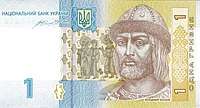 |
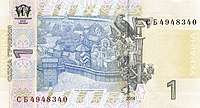 |
Yellow-blue | Volodymyr the Great of Kiev (c. 958 – 1015), Prince of Novgorod and Grand Prince of Kiev Ruler of Kievan Rus' in (980–1015) |
Volodymyr I's Fortress Wall in Kiev | 22 May 2006 |
| ₴2 118 x 63 mm |
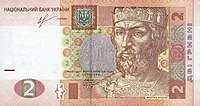 |
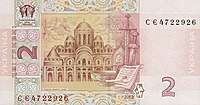 |
Orange | Yaroslav the Wise (c. 978 – 1054), Prince of Novgorod and Grand Prince of Kiev Ruler of Kievan Rus' in (1019–1054) |
Saint Sophia's Cathedral, Kiev | 24 September 2004 |
| ₴5 118 x 63 mm |
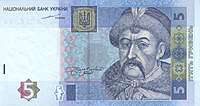 |
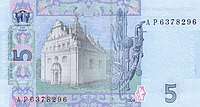 |
Blue | Bohdan Khmelnytsky (c. 1595 – 1657), Hetman of Ukraine | A church in the village of Subotiv | 14 June 2004 |
| ₴10 124 x 66 mm |
 |
 |
Crimson | Ivan Mazepa (1639–1709), Hetman of Ukraine | The Holy Dormition Cathedral of the Kiev Pechersk Lavra | 1 November 2004 |
| ₴20 130 x 69 mm |
 |
 |
Green | Ivan Franko (1856–1916), poet and writer | Lviv Theatre of Opera and Ballet | 25 September 2018 |
| ₴50 136 x 72 mm |
 |
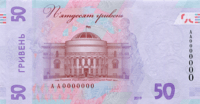 |
Violet | Mykhailo Hrushevskyi (1866–1934), historian and politician. | The Tsentralna Rada building ("House of the Teacher" in Kiev) | 20 December 2019 |
| ₴100 142 x 75 mm |
 |
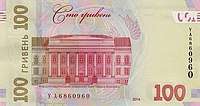 |
Olive | Taras Shevchenko (1814–1861), poet and artist | Taras Shevchenko National University of Kyiv | 9 March 2015 |
| ₴200 148 x 75 mm |
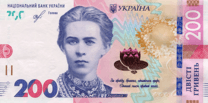 |
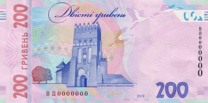 |
Pink | Lesya Ukrainka (1871–1913), poet and writer | Entrance Tower of Lutsk Castle | 25 February 2020 |
| ₴500 154 x 75 mm |
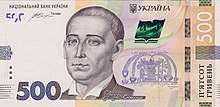 |
 |
Brown | Hryhorii Skovoroda (1722–1794), writer and composer | National University of Kyiv-Mohyla Academy | 11 April 2016 |
| ₴1,000 160 x 75 mm |
 |
 |
Blue | Volodymyr Vernadskyi (1863-1945), historian, philosopher, naturalist and scientist | National Academy of Sciences of Ukraine | 25 October 2019 |
Exchange rates
Official NBU exchange rate at moment of introduction was UAH 1.76 per 1 US dollar.[24]
Following the Asian financial crisis in 1998, the currency was devaluated to UAH 5.6 = USD 1.00 in February 2000. Later, the exchange rate remained relatively stable at around 5.4 hryvnias for 1 US dollar and was fixed to 5.05 hryvnias for 1 US dollar from 21 April 2005 until 21 May 2008. In mid-October 2008 rapid devaluation began, in the course of a global financial crisis that hit Ukraine hard, with the hryvnia dropping 38.4% from UAH 4.85 for 1 US dollar on 23 September 2008 to UAH 7.88 for 1 US dollar on 19 December 2008.[25][26] After a period of instability, a new peg of 8 hryvnias per US dollar was established, and remained for several years. In 2012, the peg was changed to a managed float (much like that of the Chinese yuan) as the euro and other European countries' currencies weakened against the dollar due to the European debt crisis, and the value in mid-2012 was about 8.14 UAH per dollar.
As from 7 February 2014, following political instability in Ukraine, the National Bank of Ukraine changed the hryvnia into a fluctuating/floating currency in an attempt to meet IMF requirements and to try to enforce a stable price for the currency in the Forex market.[27] In 2014 and 2015 the hryvnia lost about 70% of its value against the U.S. dollar.[26][28] After stabilization efforts by Ukrainian authorities in March 2015 1 US dollar was worth about 22 hryvnia.[26] Early February 2016 1 US dollar was worth about 26 hryvnia,[26] and then as of the end of 2017 it was nearly 28 hryvnia, an all-time low.[29] On July 31 2019, the hryvnia to U.S. dollar exchange rate in the interbank foreign exchange market strengthened to 24.98 — highest level in 3 years.[30]
| Current UAH exchange rates | |
|---|---|
| From Google Finance: | AUD CAD CHF EUR GBP HKD JPY USD CNY JPY |
| From Yahoo! Finance: | AUD CAD CHF EUR GBP HKD JPY USD CNY JPY |
| From XE.com: | AUD CAD CHF EUR GBP HKD JPY USD CNY JPY |
| From OANDA: | AUD CAD CHF EUR GBP HKD JPY USD CNY JPY |
| From fxtop.com: | AUD CAD CHF EUR GBP HKD JPY USD CNY JPY |
See also
References
- "National Bank of Ukraine". Bank.gov.ua. Retrieved 3 May 2019.
- "Frequently Asked Questions (FAQs)". Iso.org. Retrieved 2 April 2019.
-
- Michael Everson's "Proposal to encode the HYRVNIA SIGN and CEDI SIGN in the UCS" (PDF). 23 April 2004. Retrieved 23 April 2004.
- "National Bank of Ukraine". Bank.gov.ua. Retrieved 11 February 2017.
- "Volodymyr Matvienko. Autograph on Hryvnia" (in Ukrainian). Archived from the original on December 31, 2008.
- "Ukrainian hryvnia to be dropped in April: Crimean gov't official". CCTV News America. 18 March 2014. Archived from the original on 23 April 2014. Retrieved 18 March 2014.
- Crimea enters the rouble zone, ITAR-TASS (1 June 2014)
- ""In theory, it is possible to pay with Ukrainian hryvnias, Russian rubles, US dollars, and euros in the DPR and the LPR. However, only the two former currencies are in common use. Their exchange rate has been fixed by the governments, and is 1:2 (one hryvnia is the equivalent of two rubles). However, there is a shortage of low denomination rubles, so the Ukrainian hryvnia is still the most popular means of payment."". Osw.waw.pl. Retrieved 2 April 2019.
- "НБУ в ближайшие месяцы рассмотрит вопрос о целесообразности использования 1-2-копеечных монет". Rbc.ua. Retrieved 2 April 2019.
- "NBU Streamlines Hryvnia Banknote and Coin Denominations". NBU Streamlines Hryvnia Banknote and Coin Denominations. 25 June 2019. Retrieved 17 July 2019.
- НБУ рассмотрит вопрос введения в обращение 2-гривневой монеты [RBK will consider the issuance of 2-hryvnia coin] (in Russian). RBK Ukraina. 26 October 2012. Archived from the original on 21 February 2014.
- https://bank.gov.ua/news/all/monetami-1-2-ta-5-kopiyok-ne-mojna-rozrahovuvatisya-z-1-jovtnya-2019-roku
- "Розмінні й обігові монети". Bank.gov.ua. Retrieved 2 April 2019.
- "NBU Streamlines Hryvnia Banknote and Coin Denominations". NBU Streamlines Hryvnia Banknote and Coin Denominations. 25 June 2019. Retrieved 17 July 2019.
- "Національний банк презентував нові обігові монети". Bank.gov.ua. Retrieved 2018-04-07.
- "NBU Streamlines Hryvnia Banknote and Coin Denominations". NBU Streamlines Hryvnia Banknote and Coin Denominations. 25 June 2019. Retrieved 17 July 2019.
- Как появилась гривна [How hryvnia was born] (in Russian). Podrobnosti. 4 September 2006. Archived from the original on 13 March 2014.
- "The man who designed Hryvnia". Zerkalo Nedeli (in Russian). Archived from the original on April 23, 2008.
- "Hryvnia-Immigrant". Zerkalo Nedeli (in Ukrainian). Archived from the original on 2010-12-29.
- "NBU Starts Printing Money from Flax – Незалежний АУДИТОР". N-auditor.com.ua. Retrieved 11 February 2017.
- Brand new 1,000-hryvnia banknote put into circulation on Oct 25, UNIAN (25 October 2019)
- "Результати пошуку". Bank.gov.ua. Retrieved 11 February 2017.
- National Bank of Ukraine, historical exchange rates
- "US Dollar: CURRENCY:USD quotes & news – Google Finance". Google.com. Retrieved 11 February 2017.
- "7 лютого 2014 року Національний банк України вводить в обіг пам'ятну монету "Визволення Нікополя від фашистських загарбників"" [7 February 2014 the National Bank of Ukraine will issue commemorative coins "Nikopol Liberation from the Nazis"]. 7 February 2014. Archived from the original on 21 February 2014.
- Ukraine teeters a few steps from chaos, BBC News (5 February 2016)
- "Currency Converter - Foreign Exchange Rates - OANDA". Oanda.com. Retrieved 2 April 2019.
- US dollar in Ukraine costs less than Hr 25 for the first time in 3 years Kyiv Post, July 31 2019
Bibliography
- Krause, Chester L.; Clifford Mishler (1991). Standard Catalog of World Coins: 1801–1991 (18th ed.). Krause Publications. ISBN 0873411501.
- Cuhaj, George S. (editor) (2006). Standard Catalog of World Paper Money: Modern Issues 1961-Present (12th ed.). Krause Publications. ISBN 0-89689-356-1.CS1 maint: extra text: authors list (link)
External links
| Wikimedia Commons has media related to Money of Ukraine. |
| Wikimedia Commons has media related to Гривня. |
- History of Hryvnia
- National Bank of Ukraine announcement of Hryvnia Sign (in Ukrainian)
- Proposed symbols for hryvnia during design competition (in Ukrainian)
- Detailed Catalog of Ukrainian paper money
- Pictures of hryvnia bills introduced in 1997
- The first Ukrainian Money (1917–1922) Odessa Numismatics Museum
- Ukraine monetary reform. Numismatics (in Russian)
- List of coins of Ukraine
| Preceded by: Various |
Currency of Kievan Rus' 11th century – 15th century |
Succeeded by: Various |
| Preceded by: Ukrainian karbovanets |
Currency of Ukrainian People's Republic 1 March 1918 – April 1918 |
Succeeded by: Ukrainian karbovanets Reason: coup d'état (on 29 April 1918) |
| Preceded by: Ukrainian karbovanets Reason: coup d'état (on 14 December 1918) |
Currency of Ukrainian People's Republic December 1918 – November 1920 |
Succeeded by: Soviet karbovanets Reason: Soviet reintegration |
| Preceded by: Ukrainian karbovanets Reason: inflation (on 2 September 1996) Ratio: 1 hryvnia = 100,000 karbovanets |
Currency of Ukraine 2 September 1996 – |
Succeeded by: Current |
